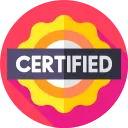FREE
daily Instructor: Dr. Jessica GallegosCourse Overview
Mastery of Polish Grammar for Teaching
In-Depth Understanding of Polish Morphology
- Comprehensive analysis of noun declensions (cases, genders, numbers), including less common or irregular forms, and strategies for explaining these complexities to learners. For example, understanding and teaching the nuances of the vocative case, which doesn't have a direct equivalent in many languages, and its appropriate usage in various contexts.
- Detailed exploration of verb conjugations, encompassing aspect (perfective vs. imperfective), tense, mood, and person. This includes teaching learners how to identify and utilize different verb forms in context, and explaining the intricate relationship between verb aspect and meaning. For example, distinguishing between 'czytać' (to read - imperfective) and 'przeczytać' (to read through - perfective) and their implications for sentence construction.
- Analysis of adjective declensions, agreement rules with nouns, and the formation of comparative and superlative forms. Focusing on the exceptions and irregularities that make adjective usage challenging for learners. For example, explaining the declension patterns of adjectives modifying masculine animate vs. masculine inanimate nouns in the accusative case.
- Mastery of pronoun usage, including personal, possessive, demonstrative, relative, and interrogative pronouns, and their declension patterns. Explaining the nuances of formal and informal pronouns (pan/pani/państwo vs. ty), and their appropriate use in different social situations.
Advanced Polish Syntax and Sentence Structure
- Deep understanding of Polish word order (SVO being the base, but with substantial flexibility), and the factors that influence word order choices, such as emphasis, topic-comment structure, and stylistic considerations. Teaching learners how to create grammatically correct and natural-sounding sentences by manipulating word order effectively.
- Comprehensive knowledge of complex sentence structures, including subordinate clauses (relative, adverbial, noun clauses), and the use of conjunctions and other linking words to connect ideas. Providing learners with the skills to analyze and construct complex sentences with accuracy and clarity. For example, explaining the use of 'że' (that) to introduce noun clauses and how the verb mood changes accordingly.
- Detailed analysis of prepositional phrases, their functions, and the case government of prepositions. Addressing common errors made by learners related to prepositional usage and providing strategies for teaching them effectively. For example, distinguishing between 'na' (on) with the accusative case indicating motion towards a location vs. 'na' with the locative case indicating a location.
- Exploration of impersonal constructions (e.g., 'trzeba', 'można') and passive voice, and their usage in different contexts. Teaching learners how to use these constructions to express ideas in a more formal or objective way.
Effective Polish Language Teaching Methodologies
Communicative Language Teaching (CLT) in the Polish Context
- Application of CLT principles to Polish language instruction, focusing on developing learners' ability to communicate effectively in real-life situations. Moving beyond grammar rules to practical application.
- Designing communicative activities and tasks that promote interaction, negotiation of meaning, and fluency development. Examples include role-playing scenarios, simulations, and problem-solving activities that require learners to use Polish in a meaningful way.
- Integrating authentic materials (e.g., Polish newspapers, films, music) into the classroom to expose learners to real-world language use and cultural context. Adapting these materials to different proficiency levels and learning objectives.
- Creating a learner-centered classroom environment that encourages active participation, collaboration, and risk-taking. Fostering a supportive and inclusive atmosphere where learners feel comfortable making mistakes and learning from them.
Task-Based Language Teaching (TBLT) in Polish
- Implementing TBLT principles in Polish language teaching, structuring lessons around meaningful tasks that require learners to use Polish to achieve specific goals.
- Designing tasks that are relevant to learners' interests and needs, and that promote the development of all four language skills (listening, speaking, reading, writing). Examples include planning a trip to Poland, writing a letter to a Polish friend, or giving a presentation on a Polish cultural topic.
- Providing learners with opportunities to plan, monitor, and evaluate their own performance during tasks. Encouraging them to reflect on their learning process and identify areas for improvement.
- Providing feedback that focuses on both accuracy and fluency, and that is tailored to learners' individual needs and learning styles.
Developing Polish Language Learning Materials
Creating Engaging and Effective Lesson Plans
- Designing lesson plans that are aligned with specific learning objectives and that cater to the diverse needs of learners. Considering factors such as proficiency level, learning styles, and cultural backgrounds.
- Selecting and adapting appropriate teaching materials, including textbooks, audio recordings, video clips, and online resources. Supplementing existing materials with original content that is tailored to learners' specific interests and needs.
- Sequencing lesson activities in a logical and engaging way, incorporating a variety of techniques to keep learners motivated and interested.
- Incorporating assessment strategies into lesson plans to monitor learners' progress and provide feedback. Using a range of assessment methods, including formative and summative assessments, to evaluate learners' understanding and skills.
Adapting and Creating Authentic Polish Language Resources
- Sourcing and adapting authentic Polish language materials (e.g., news articles, blog posts, social media content) for classroom use. Tailoring the complexity and vocabulary to different proficiency levels.
- Developing supplementary materials, such as worksheets, quizzes, and games, to reinforce key concepts and skills. Ensuring that these materials are engaging, relevant, and aligned with learning objectives.
- Creating multimedia resources, such as audio and video recordings, to enhance learners' listening comprehension and pronunciation skills. Recording dialogues and monologues with native Polish speakers.
- Designing online learning activities and resources, such as interactive exercises, online forums, and virtual tours of Poland. Utilizing technology to create a more engaging and interactive learning experience.
Addressing Common Challenges in Polish Language Learning
Overcoming Grammatical Difficulties for Learners
- Identifying common grammatical errors made by learners of Polish, such as case endings, verb aspect, and word order. Developing targeted strategies to address these errors.
- Providing clear and concise explanations of grammatical concepts, using visual aids and examples to illustrate key points. Breaking down complex grammatical rules into smaller, more manageable chunks.
- Designing interactive exercises and activities to help learners practice and internalize grammatical rules. Using a variety of techniques, such as gap-fill exercises, sentence transformations, and communicative games.
- Providing individualized feedback on learners' grammatical errors, focusing on accuracy and clarity. Encouraging learners to self-correct their errors and to develop strategies for avoiding them in the future.
Pronunciation and Phonetics in Polish Language Teaching
- Understanding the phonetic system of Polish, including vowels, consonants, and stress patterns. Teaching learners how to pronounce Polish sounds accurately.
- Addressing common pronunciation errors made by learners of Polish, such as the pronunciation of nasal vowels, palatalized consonants, and consonant clusters. Providing targeted instruction and practice to help learners overcome these challenges.
- Using phonetic transcriptions and audio recordings to help learners visualize and hear the correct pronunciation of Polish words. Encouraging learners to listen to native Polish speakers and to imitate their pronunciation.
- Incorporating pronunciation practice into all aspects of language teaching, from vocabulary acquisition to grammar exercises. Providing regular opportunities for learners to practice their pronunciation in a supportive and encouraging environment.
FlashCards
External Resources
Add-On Features
Expert Instructor
Get live study sessions from experts
Honorary Certification
Receive a certificate before completing the course.
Currency
Sign in to change your currency
I'm not ready to enroll?
Tell us why, because it matters.
Enroll With a Key
Course Benefits
Get a Job
Use your certificate to stand out and secure new job opportunities.
Earn More
Prove your skills to secure promotions and strengthen your case for higher pay
Learn a Skill
Build knowledge that stays with you and works in real life.
Lead Teams
Use your certificate to earn leadership roles and invitations to industry events.
Visa Support
Use your certificate as proof of skills to support work visa and immigration applications.
Work on Big Projects
Use your certificate to qualify for government projects, enterprise contracts, and tenders requiring formal credentials.
Win Partnerships
Use your certified expertise to attract investors, get grants, and form partnerships.
Join Networks
Use your certificate to qualify for professional associations, advisory boards, and consulting opportunities.
Stand Out Professionally
Share your certificate on LinkedIn, add it to your CV, portfolio, job applications, or professional documents.
Discussion Forum
Join the discussion!
No comments yet. Sign in to share your thoughts and connect with fellow learners.
Frequently Asked Questions
For detailed information about our Polish Language Teaching Certification course, including what you’ll learn and course objectives, please visit the "About This Course" section on this page.
The course is online, but you can select Networking Events at enrollment to meet people in person. This feature may not always be available.
We don’t have a physical office because the course is fully online. However, we partner with training providers worldwide to offer in-person sessions. You can arrange this by contacting us first and selecting features like Networking Events or Expert Instructors when enrolling.
Contact us to arrange one.
This course is accredited by Govur University, and we also offer accreditation to organizations and businesses through Govur Accreditation. For more information, visit our Accreditation Page.
Dr. Jessica Gallegos is the official representative for the Polish Language Teaching Certification course and is responsible for reviewing and scoring exam submissions. If you'd like guidance from a live instructor, you can select that option during enrollment.
The course doesn't have a fixed duration. It has 26 questions, and each question takes about 5 to 30 minutes to answer. You’ll receive your certificate once you’ve successfully answered most of the questions. Learn more here.
The course is always available, so you can start at any time that works for you!
We partner with various organizations to curate and select the best networking events, webinars, and instructor Q&A sessions throughout the year. You’ll receive more information about these opportunities when you enroll. This feature may not always be available.
You will receive a Certificate of Excellence when you score 75% or higher in the course, showing that you have learned about the course.
An Honorary Certificate allows you to receive a Certificate of Commitment right after enrolling, even if you haven’t finished the course. It’s ideal for busy professionals who need certification quickly but plan to complete the course later.
The price is based on your enrollment duration and selected features. Discounts increase with more days and features. You can also choose from plans for bundled options.
Choose a duration that fits your schedule. You can enroll for up to 180 days at a time.
No, you won't. Once you earn your certificate, you retain access to it and the completed exercises for life, even after your subscription expires. However, to take new exercises, you'll need to re-enroll if your subscription has run out.
To verify a certificate, visit the Verify Certificate page on our website and enter the 12-digit certificate ID. You can then confirm the authenticity of the certificate and review details such as the enrollment date, completed exercises, and their corresponding levels and scores.
Can't find answers to your questions?
Certification Guide

Complete the Course
Begin the course by selecting your experience level in the course content section:
Beginner: Master the material with interactive questions and enough time.
Intermediate: Get certified faster with hints and balanced questions.
Advanced: Challenge yourself with more questions and less time

Earn Your Certificate
To download and share your certificate, you must achieve a combined score of at least 75% on all questions answered.





